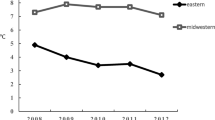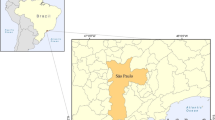Abstract
Observational studies focusing on absolute meteorological values suggest an association between meteorological parameters and stroke risk but these results are inconsistent and conflicting. Since changes in weather can provoke atrial fibrillation, we examined the association between rapid weather changes and stroke risk in 1694 patients with determinable onset of stroke symptoms in a case-crossover study in central Germany. Days one to three before stroke onset were classified as hazard periods and day seven as the respective control period. Risk of ischemic stroke in relation to 24 h differences in mean ambient temperature, relative humidity and atmospheric pressure was determined. The association between temperature and stroke risk appears to be close to linear with an increase in stroke risk of 11 % (odds ratio 1.11, 95 % confidence interval 1.01–1.22) for each 2.9 °C temperature decrease over 24 h. In individuals with a higher cardiovascular risk, stroke risk increased by 30 % (1.30, 1.06–1.61). Risk for cardioembolic strokes increased by 26 % (1.26, 1.06–1.50). Rapid positive or negative changes in relative humidity (>5 %) and atmospheric pressure (>10 hPa) increased stroke risk by a maximum of 30 % (1.30, 1.02–1.66) and 63 % (1.63, 1.10–2.42). In individuals with a higher cardiovascular risk, rapid changes in atmospheric pressure were associated with a four-times higher stroke risk (4.56, 1.26–16.43). Our results suggest that rapid decreases in ambient temperature and rapid changes in relative humidity and atmospheric pressure increase stroke risk under temperate climate conditions. Individuals with a high cardiovascular risk profile seem to be at greater risk.





Similar content being viewed by others
References
Kiu A, Horowitz JD, Stewart S. Seasonal variation in AF-related admissions to a coronary care unit in a “hot” climate: fact or fiction? J Cardiovasc Nurs. 2004;19(2):138–41.
Frost L, Johnsen SP, Pedersen L, Husted S, Engholm G, Sorensen HT, et al. Seasonal variation in hospital discharge diagnosis of atrial fibrillation: a population-based study. Epidemiology. 2002;13(2):211–5.
Doi T, Sakurai M, Hamada K, Matsumoto K, Yanagisawa K, Kikuchi N, et al. Plasma volume and blood viscosity during h sitting in a dry environment: effect of prehydration. Aviat Space Environ Med. 2004;75(6):500–4.
Lowe GD, Lee AJ, Rumley A, Price JF, Fowkes FG. Blood viscosity and risk of cardiovascular events: the Edinburgh Artery Study. Br J Haematol. 1997;96(1):168–73.
Matsumoto M, Ishikawa S, Kajii E. Cumulative effects of weather on stroke incidence: a multi-community cohort study in Japan. J Epidemiol. 2010;20(2):136–42.
Feigin VL, Nikitin YP, Bots ML, Vinogradova TE, Grobbee DE. A population-based study of the associations of stroke occurrence with weather parameters in Siberia, Russia (1982–92). Eur J Neurol. 2000;7(2):171–8.
Chang CL, Shipley M, Marmot M, Poulter N. Lower ambient temperature was associated with an increased risk of hospitalization for stroke and acute myocardial infarction in young women. J Clin Epidemiol. 2004;57(7):749–57.
Hong YC, Rha JH, Lee JT, Ha EH, Kwon HJ, Kim H. Ischemic stroke associated with decrease in temperature. Epidemiology. 2003;14(4):473–8.
Jimenez-Conde J, Ois A, Gomis M, Rodriguez-Campello A, Cuadrado-Godia E, Subirana I, et al. Weather as a trigger of stroke. Daily meteorological factors and incidence of stroke subtypes. Cerebrovasc Dis. 2008;26(4):348–54.
Morabito M, Crisci A, Vallorani R, Modesti PA, Gensini GF, Orlandini S. Innovative approaches helpful to enhance knowledge on weather-related stroke events over a wide geographical area and a large population. Stroke. 2011;42(3):593–600.
McArthur K, Dawson J, Walters M. What is it with the weather and stroke? Expert Rev Neurother. 2010;10(2):243–9.
Kyobutungi C, Grau A, Stieglbauer G, Becher H. Absolute temperature, temperature changes and stroke risk: a case-crossover study. Eur J Epidemiol. 2005;20(8):693–8.
Magalhaes R, Silva MC, Correia M, Bailey T. Are stroke occurrence and outcome related to weather parameters? Results from a population-based study in northern portugal. Cerebrovasc Dis. 2011;32(6):542–51.
Wolf PA, D’Agostino RB, Belanger AJ, Kannel WB. Probability of stroke: a risk profile from the Framingham Study. Stroke. 1991;22(3):312–8.
Adams HP Jr, Bendixen BH, Kappelle LJ, Biller J, Love BB, Gordon DL, et al. Classification of subtype of acute ischemic stroke. Definitions for use in a multicenter clinical trial. TOAST. Trial of Org 10172 in Acute Stroke Treatment. Stroke. 1993;24(1):35–41.
Brott T, Adams HP Jr, Olinger CP, Marler JR, Barsan WG, Biller J, et al. Measurements of acute cerebral infarction: a clinical examination scale. Stroke. 1989;20(7):864–70.
Peel MC, Finlayson BL, McMahon TA. Updated world map of the Koppen–Geiger climate classification. Hydrol Earth Syst Sci. 2007;11(5):1633–44.
Maclure M. The case-crossover design: a method for studying transient effects on the risk of acute events. Am J Epidemiol. 1991;133(2):144–53.
Turin TC, Kita Y, Murakami Y, Rumana N, Sugihara H, Morita Y, et al. Increase of stroke incidence after weekend regardless of traditional risk factors: Takashima Stroke Registry, Japan; 1988–2003. Cerebrovasc Dis. 2007;24(4):328–37. doi:10.1159/000106978.
Briggs DE, Felberg RA, Malkoff MD, Bratina P, Grotta JC. Should mild or moderate stroke patients be admitted to an intensive care unit? Stroke. 2001;32(4):871–6.
Kannel WB, Wolf PA, Benjamin EJ, Levy D. Prevalence, incidence, prognosis, and predisposing conditions for atrial fibrillation: population-based estimates. Am J Cardiol. 1998;82(8A):2N–9N.
Dawson J, Weir C, Wright F, Bryden C, Aslanyan S, Lees K, et al. Associations between meteorological variables and acute stroke hospital admissions in the west of Scotland. Acta Neurol Scand. 2008;117(2):85–9.
Berginer VM, Goldsmith J, Batz U, Vardi H, Shapiro Y. Clustering of strokes in association with meteorologic factors in the Negev Desert of Israel: 1981–1983. Stroke. 1989;20(1):65–9.
The International Stroke Trial (IST). A randomised trial of aspirin, subcutaneous heparin, both, or neither among 19435 patients with acute ischaemic stroke. Int Stroke Trial Collab Group. Lancet. 1997;349(9065):1569–81.
Field TS, Hill MD. Weather, Chinook, and stroke occurrence. Stroke. 2002;33(7):1751–7.
Hong YC, Lee JT, Kim H, Kwon HJ. Air pollution: a new risk factor in ischemic stroke mortality. Stroke. 2002;33(9):2165–9.
Smeeth L, Thomas SL, Hall AJ, Hubbard R, Farrington P, Vallance P. Risk of myocardial infarction and stroke after acute infection or vaccination. N Engl J Med. 2004;351(25):2611–8.
Geologie TLfUu. Umweltberichterstattung. http://www.tlug-jena.de/de/tlug/uw_bericht/2013/luft/luftqualitaet/. 2013. http://www.tlug-jena.de/de/tlug/uw_bericht/2013/luft/luftqualitaet/. Accessed 15 May 2013.
Houck PD, Lethen JE, Riggs MW, Gantt DS, Dehmer GJ. Relation of atmospheric pressure changes and the occurrences of acute myocardial infarction and stroke. Am J Cardiol. 2005;96(1):45–51.
Acknowledgments
We thank Nasim Kroegel (Jena University Hospital) for critical reading of the manuscript and her helpful suggestions.
Conflict of interest
None.
Author information
Authors and Affiliations
Corresponding author
Rights and permissions
About this article
Cite this article
Rakers, F., Schiffner, R., Rupprecht, S. et al. Rapid weather changes are associated with increased ischemic stroke risk: a case-crossover study. Eur J Epidemiol 31, 137–146 (2016). https://doi.org/10.1007/s10654-015-0060-3
Received:
Accepted:
Published:
Issue Date:
DOI: https://doi.org/10.1007/s10654-015-0060-3




